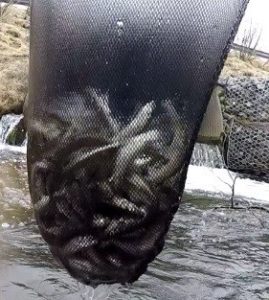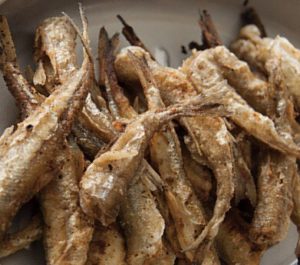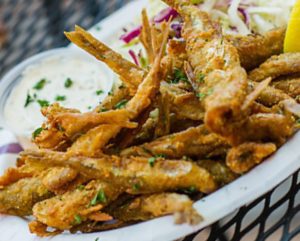SMELT ANNOUNCE THE ARRIVAL OF SPRING TO THE LAKES
 TODAY’S LESSON: As the sun begins to warm the lakes and oceans, little fish celebrate the return of Spring abounding near shore to launch the cycle of life once again. When the lake smelt starts to “run” they are at their best of the year, hearty from the cold winter waters, intertwining sweet and savory in one crunchy bite. Today we will learn the tricks to perfect the technique of fish frying.
TODAY’S LESSON: As the sun begins to warm the lakes and oceans, little fish celebrate the return of Spring abounding near shore to launch the cycle of life once again. When the lake smelt starts to “run” they are at their best of the year, hearty from the cold winter waters, intertwining sweet and savory in one crunchy bite. Today we will learn the tricks to perfect the technique of fish frying.
WHAT ARE SMELT AND WHITEBAIT? Smelt are a family of tiny fish calling home the Great Lakes, Atlantic and Pacific Oceans. There a number of related species members of the Osmeridae family, some of which are protected from harvest. Whitebait are immature tiny fish of larger ocean species such as herring, sprat, mackerel, sardines and bass, usually fried whole.
 THEY ARE SO LITTLE AND HOW DO YOU CATCH THEM? When water temperatures warm to 40 to 42 degrees F., the smelt become very active in shallow lake and river waters. The fish are located at night using flashlights then “dipped” with a nylon or fine wire net to harvest. On the Atlantic coasts Spring signals the Smelt and other small fish to run up the local estuaries where they are easily netted. The larger fish are cleaned of head, fins, and belly while the tiny ones may be simply gutted.
THEY ARE SO LITTLE AND HOW DO YOU CATCH THEM? When water temperatures warm to 40 to 42 degrees F., the smelt become very active in shallow lake and river waters. The fish are located at night using flashlights then “dipped” with a nylon or fine wire net to harvest. On the Atlantic coasts Spring signals the Smelt and other small fish to run up the local estuaries where they are easily netted. The larger fish are cleaned of head, fins, and belly while the tiny ones may be simply gutted.
GOT TO FLASH FRY TO CAPTURE THE GOODNESS! Although fried foods generally have a bad reputation of being heavy, greasy foods, crispy frying done properly produces the most delicate crunchy fish while preserving all the flavorful moist meat, like a savory French fry!
 WHY THEY TASTES SO GOOD: The second you plunge the little fish into the hot oil the high
WHY THEY TASTES SO GOOD: The second you plunge the little fish into the hot oil the high
temperature coagulates the exterior skin to form a seal to trap in moisture and flavor; thoroughly cooking in just a couple of minutes to capture all of the delicate characteristics and nutritional elements. The high temperature sears the surface and little fat will be absorbed during the cooking process if the oil is the correct high temperature.
SELECT YOUR FISH: Whole cleaned Smelt or Whitebait are my choice for spring. Select whole cleaned smelt which have a bright shiny, almost wet looking skin and smell sweet just like watermelon. If you prefer, select small fish filets which are almost translucent and dense in texture, never white and mushy. You can trim the belly flap and remove the skin if you prefer or just fry au natural. They should never feel slimy or smell fishy. The freshest quality is essential for the cooked flavor and texture.
THE SECRET SEASONED FLOUR: The simplest frying method calls to dredge the fish through a egg-milk wash, drain, and dust with a seasoned flour. The egg wash helps the flour adhere evenly to the fish and provide a complete coating when cooked.
The secret to our flour is more than just seasonings, it’s the combination of the Sorghum flour (higher protein, lower carb, gluten-lectin free) and Flaxseed meal(high fiber, Omegas). This secret flour also does not absorb as much liquid from the egg wash or the moisture exiting the fish during cooking, creating a perfect crunchy yet still delicate crust. The seasoned flour also allows more of the fish’s flavor and texture to show through. The flour itself should contain the usual seasonings of salt and pepper but is enhanced with paprika, and ground spices such as fennel seed, cumin or dill seed for a delicate accent.
NOT ALL OILS ARE MADE EQUAL: Select one of the following oils that will stand up to the temperatures of frying. These are good nutrient rich, healthy oils that have the best flavor for simple fried foods. Select naturally refined oils as the benefits of the virgin oils will be burned up by the higher frying temperatures.
Olive oil
Avocado oil
Coconut oil
Red Palm Fruit oil – the natural red carotene color will transfer to your fried goods!
AVOID USING – Most traditional oils such as corn, canola, soybean and grain oils which contain lectins and other less nutritional components.
ADVANTAGES: Flash frying with nutritionally aligned flours and oils delivers crispy delicious protein without unnecessary carbohydrates, glutens and lectins.
TRICKS OF THE TRADE: The best trick to frying is temperature. Make sure the oil is the proper temperature before attempting to cook. If you are serving a large party, have a number of skillets or fryers on the fire so all the fish may be cooked and presented quickly. Never overload the fryers, since the cold fish will cause the oil temperature to drop
resulting in soggy food.
One more tip, add the salt and pepper to the egg wash to prevent transferring from the flour into the oil which accelerate its breaking down.
THE COOKING BEGINS: Dredge your fish through the egg wash and allow to drain. Add the fish individually into the seasoned flour while shaking to coat all the surfaces evenly and prevent them from sticking together in a giant ball. Shake in a coarse sieve to remove all excess flour.
COOKING: Carefully submerge into the hot oil and cook until they begin to hiss, about 2 to 2-1/2 minutes for smelt and a little longer for larger fish. The hissing sound means they are releasing their juices and are done. Remove them to paper toweling to drain. Garnish and serve immediately on a warm platter.
SERVING SUGGESTIONS: The standard green herbed tartar sauce is tradition but lets put a twist on it…… or even just a squirt of lemon and some crispy parsley.
TRY YOUR TECHNIQUE: Smelt are running great so try this simple healthy twist on the classic.
 Crispy Flash Fried Smelt with Parsley, Meyer Lemon and Vidalia Sweet Onion Tartar
Crispy Flash Fried Smelt with Parsley, Meyer Lemon and Vidalia Sweet Onion Tartar
Makes 4 servings
Olive or other healthy oil for frying
1 bunch flat parsley leaves, washed and dried well
1 cup Sorghum flour
1 cup fine flaxseed meal
2 tablespoons smoked sweet paprika
1 tablespoon ground fennel seed
2 large eggs, lightly beaten
2 cups low or no-fat milk
2 teaspoon sea salt, fine
1 teaspoon ground white pepper or ground chipotle pepper
2 pounds cleaned small smelts
sea salt and pepper for post frying seasoning
2 lemons for garnish, cut into 1/8th wedges
Fill a large, deep, skillet with oil to a depth of 4 inches. Heat over medium high heat to 360 degrees F.
Add the parsley leaves and cook until crisp and bubbling has receded, about 1 to 2 minutes. Remove to paper toweling to drain. Run a dry, fine, small sieve through the oil to remove any remaining herb particles.
In a large bowl sift together the flour, flaxseed meal, paprika, and fennel.
In a medium bowl combine the eggs, salt, pepper and milk.
Working quickly, dredge the smelt in the egg and milk wash to thoroughly coat, then remove from the wash to drain off the excess. Transfer the smelt in small batches to the seasoned flour and shake to coat as they fall into the mix. Shake well to evenly coat all the surfaces of the smelt. Transfer the smelt to a metal cooking basket, coarse sieve or rack to remove all excess flour.
Slip the smelt into the hot oil, stirring occasionally, and fry until evenly golden, about 2 to 3 minutes depending on the size of the fish and the volume of oil. Remove the smelt to paper toweling to drain momentarily. Season with salt and pepper. Artistically stack in the center of a warm large serving platter. Garnish with crisp parsley atop, lemon wedges around and the accompanying sauce.

MEYER LEMON AND SWEET VIDALIA ONION TARTAR
Makes 2-1/2 cups
1-1/2 cup fresh avocado mayonnaise (or other healthy oil)
1 tablespoon Dijon mustard
1/4 cup fresh Meyer lemon juice
1 Meyer lemon rind grated fine
1/4 cup finely diced Vidalia Onion (brunoise 1/8″ by 1/8″)
1/4 cup capers minced
1/4 cup finely diced red pepper
1 tablespoon snipped fresh chives
1 tablespoon minced fresh parsley
2 teaspoons freshly ground black pepper
Tabasco to taste
In a bowl or with a food processor combine all the ingredients, pulsing to combine. Reserve under refrigeration.
Jimmy Schmidt